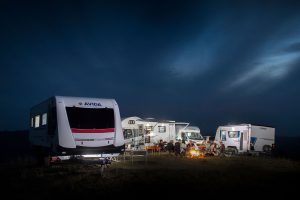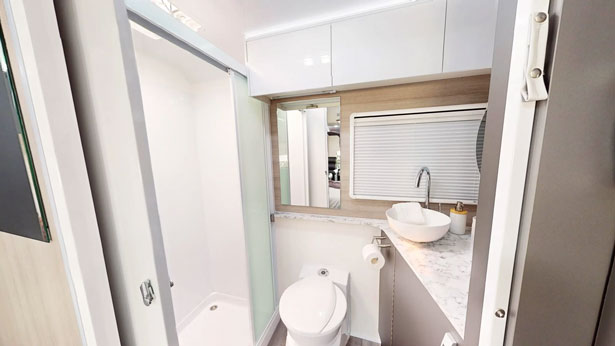
The days are getting warmer and longer. Most of us yern to hit the road and travel. If you have had your motorhome or caravan locked up over the Winter and are now getting ready to head off travelling, take a look at some of the tips below to help you get ready.
Unless you travel full time in your motorhome or caravan, you will need to consider a few things prior to hitting the open road, to ensure you have trouble free adventures.
Please note: Not all of the below points are applicable to all models.
Bringing your RV out of storage and New Season Preparation
- Completely ventilate the RV – Your RV has probably been locked up for a few months, so the air inside has become stale. Open up all the windows and doors in your RV to let some fresh air flow through your vehicle.
- Check window operation – Ensure that your windows are working correctly, lubricate or tighten anything that is tight or loose, so your windows open easily.
- Check cabinet and door hinges – Lubricate with penetrating oil, if necessary.
- Close all taps and drain valves – If you closed all your taps and drain valves prior to storing your RV you need to ensure that you open them back up.
- Flush out your fresh water tanks and sanitise – Water is precious. When you are on the road, you rely on a clean source of water for cooking, drinking, washing dishes and showering. Ensure you flush out your fresh water tanks to make sure your water is ideal for consuming. Sanitise the water system refer to ‘Sanitising the Storage Water System’ from your owners manual.
- Fill water tanks – Once tanks are filled check for leaks especially at junctions. Also make sure all hangers and supports are securely in place.
- Check operation of all taps – Ensure faucet washers have not hardened during storage, replace if necessary.
- LPG system and appliances – Reinstall your LPG bottles on their mounts and connect the hose. Make sure the hose is fitted tightly by turning on the propane valve a little bit to open the gas line. Check to ensure for leaks using a leak detector or soapy water. Apply soapy water to each of the hose connectors using a sponge or small spray bottle. Watch to see if any bubbles form, indicating that there may be a leak. Tighten the fitting and repeat the process to make sure it is tightly connected.
- Check around all appliances – After your LPG bottles are reinstalled, check that all of your LP gas-fired appliances are working properly by opening the gas line and testing each appliance. When testing the hot water heater, make sure it is full of water first. Ensure there are no obstructions and ensure that all vent openings are clear. If any of your gas appliances are not working, book into a service centre with a certified RV maintenance provider. LPG leaks or ignition issues can be dangerous and are best handled by professionals. Find an authorised Avida Service centre near you.
- Test 240-volt appliances – Once you are happy that the LPG appliances are all working correctly. Connect your RV to 240-volt mains electricity. Start the refrigerator and check for proper cooling. Check other 240-volt appliances such as air conditioning and microwave oven to ensure they are operational.
- Check Safety Devices – Ensure your safety devices are working correctly and are within date. Smoke detector, fire extinguisher and LPG detector are all operational.
- Clean – Sweep or vacuum out your RV. Give all your surfaces a good wipe down with appropriate cleaning agents. We suggest warm soapy water with a couple of drops of essential oil such as eucalyptus to give the RV a freshen up. Vacuum out cupboards where dust may have settled over the storage period. Make sure no vermin has decided to make your RV a home over the winter, check every nook and cranny. Clean or replace filters in air conditioning units. Wash windows and fly screens. Change linen and towels that may have been left over the storage period.
- Batteries – Your RV batteries will loose a percentage of their charge due to internal leakage. If they are not periodically checked and recharged during the off-season, your RV batteries lose a small percent of their charge each month that they are in storage. By keeping your batteries charged during storage, you can extend the lifespan of your RV batteries and will be ready to go when the season starts! Check your batteries with a volt meter. Make sure your RV is not connected to electricity, or you will get a false reading. A fully charged 12-volt RV battery will actually read about 12.7-volts. If your battery reads just 12 volts or below, it should be charged before you take your RV on the road.To charge your RV batteries, attach the battery charger to the RV charger while the battery charger is turned off. Turn the battery charger on and allow the battery to charge completely. Depending on the battery size, your RV batteries may need to charge for a few hours or a few days.After the battery is charged, check the water level in the battery and add distilled water to reach the correct level. If the water level is below the plates, water should be added before charging the battery, as the plates should always remain covered.When reinstalling your RV battery, check that it is connected securely. If you are not confident in checking and installing your battery on your own, contact an nearest dealers service centre to perform this RV spring maintenance task for you. Replace batteries if necessary and check out electrical systems to make sure all lights and electrical components operate on 12 and 240 volt.
- Check your Exterior – After washing accumulated grime from the RV exterior, carefully inspect the seams and caulking for cracks that may have appeared around window frames and vents and any other joints that may have separated Re – caulk: if necessary, it is quite simple. Appropriate compounds are sold at Avida Dealers and the material is quickly and easily applied. Also, inspect weather seals around doors etc. and if necessary, have a Dealer replace immediately.If you have a caravan, inspect the hitch components for rust and damage. Replace any damaged parts now to avoid an accident or getting stuck out on the road with a broken hitch.
- Tyres – During the months in storage, your RV tyres will lose about two to three psi of air pressure each month. If your RV is stored outside or somewhere cold, your tyres may be even more deflated when you uncover your RV. Driving your RV with underinflated tyres can cause poor handling, uneven wear, a blowout and may even lead to an accident. Check tyres for proper inflation pressure. You can find your tyre pressure on the sidewall of your tyre. Don’t forget to check the spare, you never know when you may need it.
- Engine – If you have a motorhome or even a caravan you should test the engine or tow vehicle engine prior to setting off. Inspect the RV engine by checking all engine fluid levels and making sure all lights and controls are operational. Check the fluid levels of the power steering, transmission, engine oil, brake fluid, engine coolant and windshield washer fluid. If any levels are low, top them off before your first camping adventure or have your RV serviced. If you are concerned that there is a leak in any part of the engine, take your RV to a certified mechanic. After checking the engine fluid levels, hop in the driver’s seat and start the engine. Check the readings on all gauges and verify that all dash lights, headlights, taillights and windshield wipers are working.
- Generator – If your RV has an onboard generator or you carry a generator, check the oil level. If oil levels are low, have your generator serviced by a professional. Before testing your generator, check the exhaust system for any damage. Operating a generator with a damaged exhaust system can harm the generator and lead to serious consequences. After inspecting the exhaust, turn the generator on to test it. If you used your RV generator during storage, it should start up easily. If the generator was not operated at all during storage, run it for a few hours with a half-rated load. Refer to the generator owners manual for load ratings. If your generator surges or will not start, have it inspected and repaired.
- Restock first aid and emergency supplies – Another crucial step for RV safety is to restock your RV first aid and emergency supplies as part of your RV spring preparation. Check the expiration dates on any medicines and restock any first aid supplies that are low. Get rid of any dry food that has expired and make sure your RV has plenty of bottled water in case of an emergency. Your RV emergency kit should also include tools and other supplies for emergency RV repairs, such as pliers, a hammer, screwdrivers, extra oil and coolant, hoses, batteries and levelling blocks.
- Insurance, registration and RV roadside assistance – Ensure that your insurance, roadside assistance and registration is current and has not lapsed. Store your paperwork in an easy to access location in your RV just in case you need it.
With a little prior preparation it will ensure that your travelling is smooth sailing.
If in doubt call your local Avida Dealer and they will be happy to assist you.
Happy Motorhoming and Caravaning




